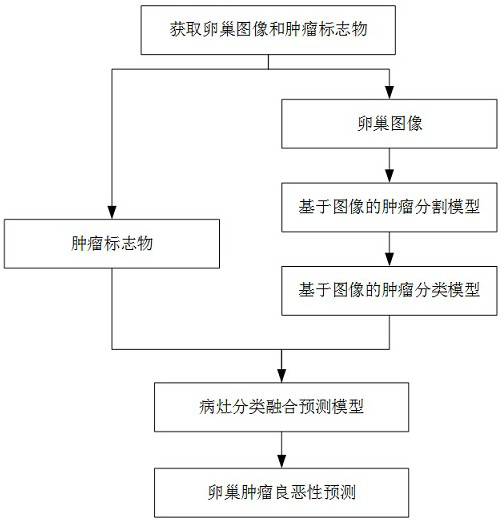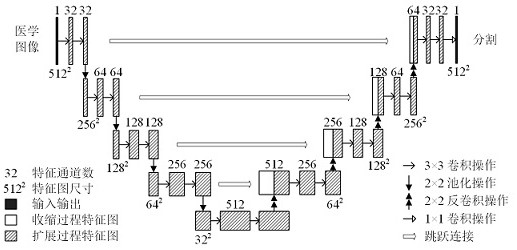Computer-aided diagnosis and treatment system based on benign and malignant ovarian tumor prediction model
A computer-aided and predictive model technology, applied in the field of medical image analysis, can solve problems such as the difficulty of special-shaped masses and the difficulty of eliminating noise interference, and achieve the effect of high accuracy and good identification ability
- Summary
- Abstract
- Description
- Claims
- Application Information
AI Technical Summary
Problems solved by technology
Method used
Image
Examples
Embodiment 1
[0044] A computer-aided diagnosis and treatment system based on a benign and malignant prediction model of ovarian tumors, the system performs the following steps, and the flow chart is as follows: figure 1 shown:
[0045] S1, obtaining ovarian images and corresponding tumor markers;
[0046] S2, inputting the ovarian image and the corresponding tumor markers into the trained ovarian tumor benign and malignant prediction model, and outputting a tumor judgment result, where the judgment result is a benign tumor or a malignant tumor;
[0047] Wherein, the ovarian tumor benign and malignant prediction model includes an image-based tumor segmentation model, an image-based tumor classification model and a lesion classification fusion prediction model;
[0048] The ovarian image is input into the image-based tumor segmentation model to obtain tumor segmentation results; the tumor segmentation results are input into the image-based tumor classification model to obtain image-based tu...
Embodiment 2
[0068] As a specific example, figure 2 The overall framework for the identification of benign and malignant ovarian tumors is given in , and the acquired ovarian images are sequentially processed by the image-based tumor segmentation model and the image-based tumor classification model to obtain the image-based tumor prediction results; then the image-based tumor prediction results are obtained. After feature combination with tumor markers, combined features are generated, and the combined features are input into the lesion classification fusion prediction model to output the benign and malignant prediction results of ovarian tumors.
[0069] The benign and malignant ovarian tumor prediction model is an important part of the system of the present invention, and the training process of the model mainly includes the training of the image-based tumor segmentation model and the training of the lesion classification model. The training process of the model is as follows Figure 5...
Embodiment 3
[0099] The method of the present invention is verified by using the data of 486 patients in a hospital, and the diagnosis results of the 486 patients with ovarian tumor diseases include benign tumors and malignant tumors. The data included the patient's 5 ovarian tumor-related tumor marker test results and menopause status. Among them, tumor markers include alpha-fetoprotein (AFP), carcinoembryonic antigen (CEA), cancer antigen (CA125), human epididymal protein 4 (HE4) and cancer antigen 19-9 (CA19-9). The lesions of all cases were diagnosed by postoperative pathological examination, so this dataset is real and reliable. According to the reference range of tumor markers in Table 2, the examination results are processed into binary features. Processing into binary features means that according to the normal range value provided by the doctor, the value in the normal range is converted to 0, which means "normal" , values outside the normal range are converted to 1, meaning "u...
PUM
 Login to View More
Login to View More Abstract
Description
Claims
Application Information
 Login to View More
Login to View More - R&D
- Intellectual Property
- Life Sciences
- Materials
- Tech Scout
- Unparalleled Data Quality
- Higher Quality Content
- 60% Fewer Hallucinations
Browse by: Latest US Patents, China's latest patents, Technical Efficacy Thesaurus, Application Domain, Technology Topic, Popular Technical Reports.
© 2025 PatSnap. All rights reserved.Legal|Privacy policy|Modern Slavery Act Transparency Statement|Sitemap|About US| Contact US: help@patsnap.com



